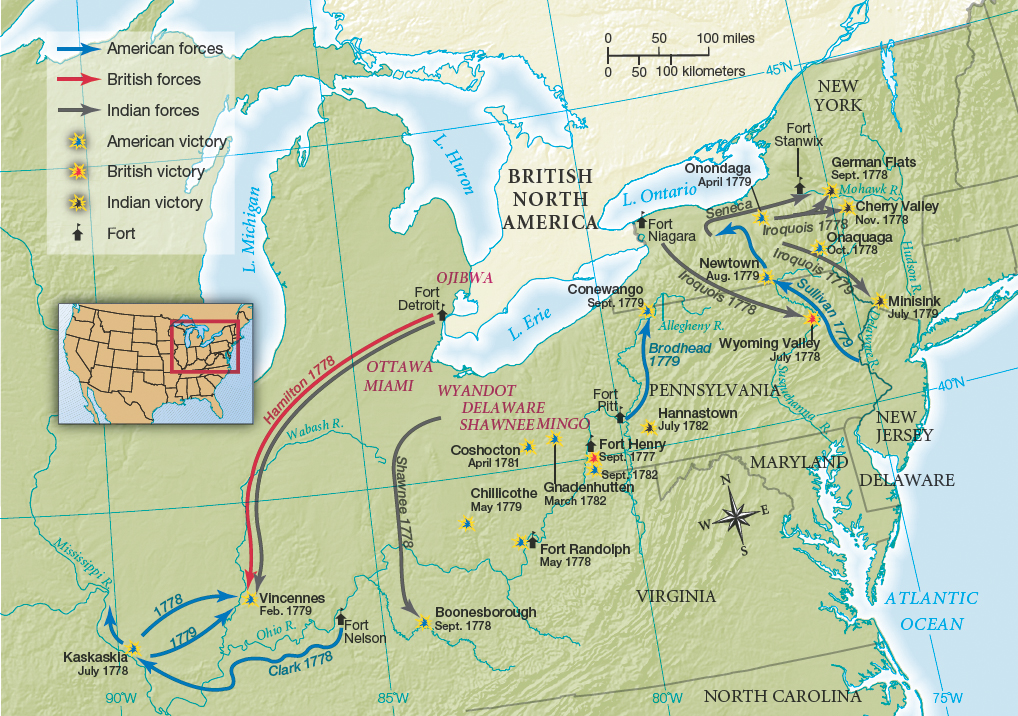The War in the West: Indian Country.
Printed Page 177 Chapter Chronology
The War in the West: Indian Country. Between the fall of 1777 and the summer of 1778, the fighting on the Atlantic coast slowed. But in the interior western areas — the Mohawk Valley, the Ohio Valley, and Kentucky — the war of Indians against the American rebels heated up.
The ambush and slaughter at Oriskany in August 1777 marked the beginning of three years of terror for the inhabitants of the Mohawk Valley. Loyalists and Indians engaged in many raids throughout 1778, capturing or killing inhabitants. In retaliation, American militiamen destroyed Joseph Brant's village, killing several children. A month later, Brant's warriors attacked the town of Cherry Valley, killing 16 soldiers and 32 civilians.
The following summer, General Washington authorized a campaign to wreak "total destruction and devastation" on all the Iroquois villages of central New York. Some 4,500 troops commanded by General John Sullivan implemented a campaign of terror in the fall of 1779. Forty Indian towns met with total obliteration; the soldiers torched dwellings, cornfields, and orchards. In a few towns, women and children were slaughtered, but in most, the inhabitants managed to escape, fleeing to the British at Fort Niagara. Thousands of Indian refugees, sick and starving, camped around the fort in one of the most miserable winters on record.
Much farther to the west, beyond Fort Pitt, another complex story of alliances and betrayals between American militiamen and Indians unfolded. Some 150,000 native people lived between the Appalachian Mountains and the Mississippi River. Most sided with the British, but a portion of the Shawnee and Delaware at first sought peace with the Americans. In mid-1778, the Delaware chief White Eyes negotiated a treaty at Fort Pitt, pledging Indian support for the Americans in exchange for supplies and trade goods. But escalating violence undermined the agreement. That fall, when American soldiers killed two friendly Shawnee chiefs, Cornstalk and Red Hawk, the Continental Congress hastened to apologize, as did the governors of Pennsylvania and Virginia, but the soldiers who stood trial for the murders were acquitted. Two months later, White Eyes died under mysterious circumstances, almost certainly murdered by militiamen, who repeatedly had trouble honoring distinctions between allied and enemy Indians.
West of North Carolina (today's Tennessee), militias attacked Cherokee settlements in 1779, destroying thirty-six villages, while Indian raiders repeatedly attacked white settlements such as Boonesborough (in present-day Kentucky) (Map 7.3). In retaliation, a young Virginian, George Rogers Clark, led Kentucky militiamen into what is now Illinois, attacking and taking the British fort at Kaskaskia. Clark's men wore native clothing — hunting shirts and breechcloths — but their dress was not a sign of solidarity with the Indians. When they attacked British-held Fort Vincennes in 1779, Clark's troops tomahawked Indian captives and threw their still-live bodies into the river in a gory spectacle witnessed by the redcoats. "To excel them in barbarity is the only way to make war upon Indians," Clark announced.

By 1780, very few Indians remained neutral. Violent raids by Americans drove Indians into the arms of the British at Forts Detroit and Niagara, or into the arms of the Spaniards, west of the Mississippi River. Said one officer on the Sullivan campaign, "Their nests are destroyed but the birds are still on the wing." For those who stayed near their native lands, chaos and confusion prevailed. Rare as it was, Indian support for the American side occasionally emerged out of a strategic sense that the Americans were unstoppable in their westward pressure and that it was better to work out an alliance than to lose in a war. But American treatment of even friendly Indians showed that there was no winning strategy for them.